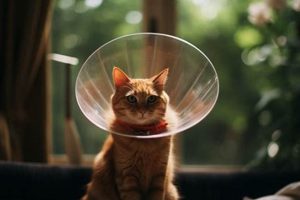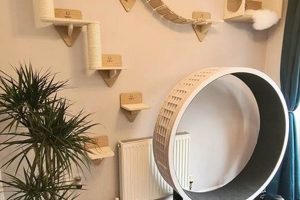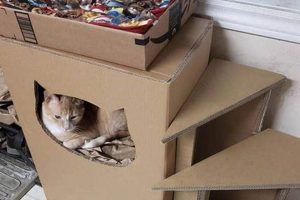Creating a homemade adaptation of the enigmatic feline from Lewis Carroll’s Alice’s Adventures in Wonderland involves a do-it-yourself approach to constructing a recognizable outfit. This undertaking often includes crafting items like striped clothing, a tail, ears, and facial makeup to replicate the character’s distinctive grin. For instance, one might choose to sew a purple and pink striped top and pants, fashion a tail from felt, and apply theatrical makeup to achieve the iconic smile.
The appeal of creating personalized character representations stems from the opportunities for individual expression and cost savings when compared to purchasing pre-made ensembles. Historically, crafting one’s own garments and accessories has been a common practice, allowing individuals to showcase their creativity and resourcefulness. Furthermore, a self-made interpretation fosters a deeper connection with the character being portrayed, adding a layer of personal significance to the activity.
Subsequent sections will explore specific methods for designing and constructing various components of the character’s attire, including clothing options, makeup techniques, and accessory creation. Guidance on adapting these techniques for different age groups and skill levels will also be provided.
Tips for a Successful Cheshire Cat Costume
Achieving a recognizable and well-executed portrayal of the grinning feline requires attention to detail and thoughtful planning. The following tips provide guidance for creating a successful self-made adaptation of this iconic character.
Tip 1: Prioritize Striped Fabric Selection. The character’s signature stripes are crucial. Opt for fabrics with clear, contrasting colors, such as classic purple and pink, or explore variations for a unique interpretation. Ensure the fabric is suitable for the intended garment type a heavier knit for pants versus a lighter woven for a top, for instance.
Tip 2: Master the Grin. The makeup application is paramount. Practice applying white face paint as a base, then use eyeliner or face paint to create exaggerated smile lines extending beyond the natural mouth. Consider using stencils for consistent line thickness and symmetry.
Tip 3: Tail Construction and Attachment. The tail should be proportionate to the wearer and securely attached. Utilize wire within the tail’s construction to allow for posing and shaping. Methods for attachment include sewing it directly to a garment or using a belt loop system.
Tip 4: Ear Design and Placement. Ears can be crafted from felt, foam, or cardstock. Consider using a headband or clips for secure attachment. The placement should be slightly angled forward to mimic a feline appearance.
Tip 5: Scale Appropriately for the Wearer. Adjust the size and details of the outfit to suit the wearer’s age and body type. Avoid overly exaggerated features on younger children for safety reasons.
Tip 6: Source Reference Material. Consult various depictions of the character from different adaptations of Alice in Wonderland to gain inspiration and ensure accuracy of details, such as stripe patterns and color palettes.
Tip 7: Consider Comfort. While aesthetics are important, prioritizing comfort is crucial, especially for extended wear. Select breathable fabrics and avoid restrictive designs that may cause discomfort or overheating.
By focusing on key elements and careful execution, a distinctive and memorable representation of the character can be achieved. Attention to detail, comfort, and scale contribute to a successful outcome.
The next section will address specific considerations for adapting the character’s appearance for different age groups and skill levels.
1. Striped Garments
The creation of striped garments constitutes a central element in the successful execution of a do-it-yourself adaptation of the Cheshire Cat character. The cause-and-effect relationship is direct: the presence of distinctive striped patterns on the attire significantly enhances the recognizability of the overall ensemble. Without such patterns, the costume may lack the immediate visual cues associated with the character. The importance of these garments stems from their role as a primary identifier; viewers often rely on the striped motif to quickly associate the wearer with the Alice in Wonderland figure.
Real-life examples demonstrate the impact of striped garments. Consider two iterations: one utilizing accurately colored and proportionally sized stripes, and another employing solid colors instead. The former elicits immediate recognition, while the latter may require additional features, such as elaborate makeup or accessories, to establish character identity. Practically, this understanding dictates that significant effort should be allocated to accurately replicating the striped pattern. Options range from sewing custom garments from striped fabric to modifying existing clothing with paint or fabric markers. Each technique presents varying levels of difficulty and cost, influencing the overall project feasibility.
In summary, the choice and execution of striped garments directly determine the efficacy of a self-made adaptation. While alternative approaches might be considered, accurately recreating the distinctive striped pattern remains a pivotal element. Challenges associated with fabric availability, pattern matching, and application techniques should be addressed early in the process. The effort invested in achieving a visually compelling striped pattern directly translates to the overall impact and recognizability of the Cheshire Cat creation.
2. Facial Makeup
Facial makeup constitutes a critical element within the scope of Cheshire Cat costume DIY endeavors. A direct correlation exists between the quality and accuracy of the makeup application and the overall success of the costume. The distinctive grin, a defining characteristic of the feline, is primarily achieved through skillful use of makeup. Without appropriately applied facial paint and contouring, the costume risks failing to capture the essence of the character. The importance of makeup resides in its capacity to transform the wearer’s face, creating a recognizable and compelling representation of the fictional figure.
Real-life examples demonstrate the significant impact of facial makeup on audience perception. Consider two iterations of the costume: one featuring a meticulously rendered, exaggerated smile with precise contouring and shading, and the other with a simple, minimally defined smile. The former elicits immediate recognition and a stronger visual association with the source material. The latter, while still suggestive of the character, lacks the same impact and may appear less refined. Practically, this understanding underscores the necessity of dedicating time and effort to mastering relevant makeup techniques. This might involve practicing the application of white base paint, delineating the smile with precision using eyeliner or face paint, and employing shading to create depth and dimension. The use of reference images from various depictions of the Cheshire Cat aids in replicating the desired aesthetic.
In summary, facial makeup functions as a transformative tool within the broader context of DIY costume construction. While other components, such as striped garments and accessories, contribute to the overall effect, the accuracy and artistry of the facial makeup play a pivotal role in conveying the character’s essence. Potential challenges include achieving symmetry, blending colors effectively, and ensuring the makeup remains durable throughout wear. Overcoming these challenges necessitates practice, experimentation with different products, and attention to detail, thereby ensuring a convincing and memorable portrayal of the Cheshire Cat.
3. Attached Tail
The integration of an attached tail is a crucial component of the Cheshire Cat costume DIY process. Its presence significantly enhances the visual representation of the character, contributing to the overall fidelity and recognizability of the self-made ensemble. The tail serves as a key physical attribute, distinguishing the costume from generic feline representations.
- Material Selection and Construction
The choice of materials and construction techniques directly impacts the realism and durability of the tail. Options range from lightweight felt to plush faux fur, each offering varying degrees of visual appeal and comfort. A well-constructed tail will maintain its shape and integrity throughout wear, avoiding sagging or distortion. Examples include a wire-reinforced tail that allows for posing and shaping versus a simple, unstuffed fabric tail that lacks dimension.
- Attachment Method and Security
The method of attaching the tail to the costume is critical for both aesthetics and practicality. Secure attachment is essential to prevent detachment during movement, ensuring the costume remains intact. Common methods include sewing directly to a garment, utilizing a belt loop system, or employing safety pins. A reinforced attachment point can distribute stress and prevent tearing, especially with heavier tail constructions.
- Proportionality and Length
The length and proportionality of the tail relative to the wearer’s size and overall costume design are important considerations. A tail that is excessively long or short can appear unbalanced or detract from the overall aesthetic. Accurate measurements and adjustments are necessary to ensure the tail complements the wearer’s physique and maintains visual harmony.
- Color and Striping Integration
The tail should seamlessly integrate with the costume’s color scheme, particularly the characteristic stripes. Employing identical or complementary colors and patterns enhances the overall cohesion of the ensemble. The accurate replication of the striped pattern on the tail reinforces the association with the Cheshire Cat character. Omitting this attention to detail can result in a disjointed or less convincing appearance.
These facets of the attached tail highlight its importance within the context of a self-made Cheshire Cat costume. Successfully addressing each element contributes to a more authentic and visually compelling representation. The tail, therefore, transcends a mere accessory, becoming an integral element defining the character’s physical manifestation.
4. Ears/Headpiece
The construction of ears or a headpiece represents an essential phase within the comprehensive Cheshire Cat costume DIY undertaking. A cause-and-effect relationship dictates that the presence of well-crafted ears or an integrated headpiece significantly enhances the character’s recognizability. Without these elements, the costume risks appearing incomplete or generic, diminishing its association with the source material. The importance of the ears or headpiece lies in their capacity to visually communicate the feline nature of the character, particularly when combined with striped garments and distinct facial makeup. For instance, consider two individuals, both wearing striped clothing and Cheshire Cat-inspired makeup: the one with prominent, stylized ears immediately conveys a clearer and more direct association with the specific character.
Furthermore, the practical significance of this understanding impacts the creative process. The selection of materials, design considerations, and attachment methods must align with the overall aesthetic goals. Real-world applications of this knowledge involve choosing between fabric, foam, or even 3D-printed components for the ears. The choice of a headband, clips, or direct attachment to a wig or hood informs the overall comfort and stability of the headpiece. Proper construction ensures the ears maintain their shape and position, preventing them from drooping or becoming dislodged during wear. A poorly designed or executed headpiece can detract from the costume’s overall impact, highlighting the importance of careful planning and execution.
In summary, the incorporation of ears or a headpiece serves as a critical step in crafting a compelling Cheshire Cat costume. A successful creation requires careful consideration of materials, design, and attachment methods to ensure both visual appeal and practical functionality. The absence or inadequate execution of this element compromises the costume’s overall effectiveness. Consequently, resources and attention should be allocated to this aspect to achieve a more authentic and recognizable representation of the character.
5. Personalized Grin
The integration of a personalized grin is a defining element within the context of a do-it-yourself (DIY) adaptation of the Cheshire Cat character. A direct relationship exists between the degree of personalization applied to the grin and the uniqueness of the final costume. While adherence to the character’s established aesthetic is important, the freedom to inject individuality through a personalized grin differentiates a DIY creation from mass-produced alternatives. The importance of this personalization stems from its ability to showcase the creator’s skill and interpretation of the source material, resulting in a more distinct and memorable portrayal. For example, individuals might choose to emphasize the width of the smile, the curvature of the lips, or the prominence of the teeth, deviating from standard depictions to create a customized effect.
This concept extends beyond mere aesthetic variation; it allows for the incorporation of relevant symbolic elements. A personalized grin might include subtle thematic additions, such as tiny playing card motifs or references to other characters or settings within Alice’s Adventures in Wonderland. Practically, this understanding dictates that creators experiment with various makeup techniques, including contouring, shading, and highlighting, to achieve the desired personalized effect. Consideration of the wearer’s facial structure, skin tone, and comfort levels is crucial. Reference images of the character’s grin from different adaptations of the story can provide inspiration, but the ultimate goal is to create a version that is both recognizable and uniquely individual.
In summary, the personalized grin serves as a crucial component within the broader sphere of Cheshire Cat costume DIY, enabling individual expression and fostering a stronger connection between the creator and their creation. While challenges may arise in achieving a balance between personalization and adherence to the character’s established visual identity, the potential rewardsa unique, memorable, and personally significant costumemake the effort worthwhile. By intentionally incorporating personalized touches, the creator elevates the costume from a mere imitation to a distinctive work of individual artistry.
Frequently Asked Questions Regarding Cheshire Cat Costume DIY
This section addresses common inquiries and potential misconceptions associated with creating a do-it-yourself adaptation of the Cheshire Cat character. These responses aim to provide clarity and inform decision-making throughout the costume construction process.
Question 1: What is the recommended fabric for the striped garments?
The selection of fabric depends on the desired aesthetic and level of comfort. Knit fabrics, such as jersey or interlock, offer flexibility and ease of movement. Woven fabrics, such as broadcloth or poplin, provide a more structured appearance. The fabric weight should correspond to the intended garment type; lighter weights are suitable for tops, while heavier weights are appropriate for pants or skirts.
Question 2: How can the signature grin be effectively replicated using makeup?
Achieving a recognizable grin requires careful application of white face paint as a base, followed by the precise delineation of the smile lines using eyeliner or face paint. Contouring techniques, involving shading and highlighting, add depth and dimension. Practice is essential to achieving symmetry and avoiding an uneven or distorted appearance.
Question 3: What are the various methods for attaching the tail to the costume?
Attachment methods include direct sewing to a garment, utilizing a belt loop system, or employing safety pins. Sewing offers the most secure and durable attachment, while belt loops provide flexibility and removability. Safety pins are a temporary solution best suited for quick adjustments. The chosen method should correspond to the weight and size of the tail to ensure stability.
Question 4: What materials are suitable for constructing the character’s ears?
Ears can be crafted from felt, foam, cardstock, or even 3D-printed materials. Felt offers flexibility and ease of manipulation, while foam provides structure and volume. Cardstock is a cost-effective option for temporary or lightweight ears. The choice of material depends on the desired aesthetic and level of durability.
Question 5: How can a personalized element be incorporated into the costume without compromising its recognizability?
Personalization can be introduced through subtle modifications to the grin, variations in the color palette, or the addition of thematic accessories. Maintaining the core attributes of the character, such as the stripes and the exaggerated smile, is essential. Small deviations from the standard depiction can create a unique and memorable effect without sacrificing recognizability.
Question 6: What are the primary safety considerations when constructing a costume for a child?
Safety considerations include avoiding small, detachable components that could pose a choking hazard, selecting non-toxic materials for makeup and construction, and ensuring the costume allows for unrestricted movement and visibility. Overly restrictive designs or cumbersome accessories should be avoided.
These answers aim to address the most pressing concerns regarding the undertaking. By understanding the intricacies of material selection, makeup application, attachment methods, and safety precautions, the creation of the most appropriate Cheshire Cat costume is ensured.
The subsequent section will offer concluding remarks summarizing the key insights from this exploration.
Conclusion
The preceding exploration of “cheshire cat costume diy” has delineated the multifaceted aspects of crafting a recognizable and individualized representation of the iconic character. Key considerations have been identified, encompassing striped garment creation, facial makeup techniques, tail construction, headpiece design, and the incorporation of personalized elements. Successful execution necessitates a balance between adherence to the established visual cues of the character and the infusion of unique, creative expressions. The detailed discussions and recommendations aim to equip individuals with the knowledge necessary to undertake this task.
Effective implementation of these insights demands a commitment to precision, attention to detail, and a willingness to experiment with different techniques. While the creation of a do-it-yourself adaptation presents inherent challenges, the potential for a distinctive and memorable portrayal of the Cheshire Cat remains a compelling incentive. Continued refinement of these skills and a thoughtful approach to material selection and construction will undoubtedly yield even more inventive and captivating interpretations of this enduring literary figure. By investing time in research and development, the final product will yield increased recognizability and satisfaction.







